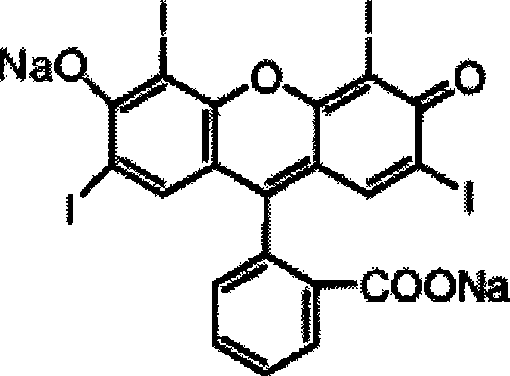Aqueous antiseptic solution and compatible anionic dye for staining skin
A technology of anionic dyes and aqueous solutions, applied in the field of cationic dyes, can solve the problem of uneven distribution of colored solutions
- Summary
- Abstract
- Description
- Claims
- Application Information
AI Technical Summary
Problems solved by technology
Method used
Image
Examples
Embodiment 1
[0035] The compatibility of anionic dyes alone with aqueous CHG (ie without addition of cationic excipients) was tested. A 0.13% w / v anionic dye solution was prepared by dissolving 0.13g FD&C Yellow 6 in 100ml distilled water. 20% w / v CHG in water was then added dropwise to the dye solution. After adding two drops of aqueous CHG to the dye solution, a precipitate formed, demonstrating the incompatibility of the dye alone with aqueous CHG.
Embodiment 2
[0037] To test the compatibility of anionic dyes and cationic excipients, various solutions were prepared with different anionic dyes and cationic excipients. The cationic excipients tested included: CPC, cetyltrimethylammonium bromide, benzethonium chloride and benzalkonium chloride. The anionic dyes tested included: FD&C Green No. 3 (Fast Green FCF), FD&C Yellow No. 5 (Tartrazine), FD&C Red No. 40 (Brilliant Red), FD&C Yellow No. 6 (Sunset Yellow FCF), FD&C Blue No. 1 (Vivid Blue FCF), FD&C Blue No. 2 (Indigo Carmine), and FD&C Red No. 3 (erythrosine). The chemical structures and chemical classes of the various pigments mentioned above are shown below.
[0038]
[0039] Chemical Name: FD&C Green No. 3 Chemical Name: FD&C Yellow No. 5
[0040] Chemical class: Triaryl methane Chemical class: Azo
[0041]
[0042] Chemical Name: FD&C Red No. 40 Chemical Name: FD&C Yellow No. 6
[0043] Chemical Class: Azo Chemical Class: Azo
[0044]
[0045] Chemical Name: ...
Embodiment 3
[0052] A titration experiment was designed to determine the appropriate molar ratio of cationic excipient to anionic dye. Experiments were performed using CPC as cationic excipient and FD&C Yellow No. 6 as dye. Place a known volume of 4mM CPC solution in a beaker and titrate 2% w / v FD&C Yellow No. 6 solution for titration experiment. A solution containing CPC and FD&C Yellow No. 6 was added dropwise to 2.0% w / v CHG in water. The results show that the minimum molar ratio of CPC to FD&C Yellow No. 6 is about 2:1. This result represents the charge ratio between the two components.
PUM
 Login to View More
Login to View More Abstract
Description
Claims
Application Information
 Login to View More
Login to View More - R&D
- Intellectual Property
- Life Sciences
- Materials
- Tech Scout
- Unparalleled Data Quality
- Higher Quality Content
- 60% Fewer Hallucinations
Browse by: Latest US Patents, China's latest patents, Technical Efficacy Thesaurus, Application Domain, Technology Topic, Popular Technical Reports.
© 2025 PatSnap. All rights reserved.Legal|Privacy policy|Modern Slavery Act Transparency Statement|Sitemap|About US| Contact US: help@patsnap.com


